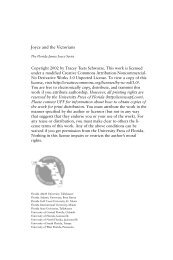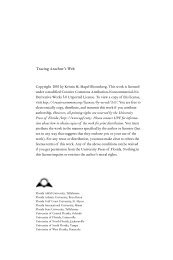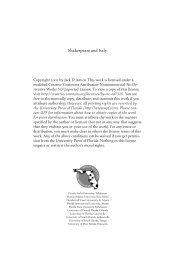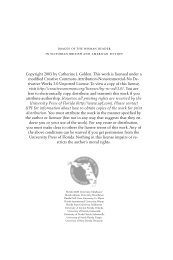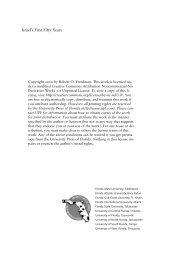Bernard Shaw's Remarkable Religion: A Faith That Fits the Facts
Bernard Shaw's Remarkable Religion: A Faith That Fits the Facts
Bernard Shaw's Remarkable Religion: A Faith That Fits the Facts
You also want an ePaper? Increase the reach of your titles
YUMPU automatically turns print PDFs into web optimized ePapers that Google loves.
100 <strong>Bernard</strong> Shaw’s <strong>Remarkable</strong> <strong>Religion</strong><br />
geoisie could shift all <strong>the</strong> blame for <strong>the</strong> evils depicted on <strong>the</strong> likes of Sartorius,<br />
Blanche, and Trench, thus allowing <strong>the</strong>mselves to wallow in selfrighteousness.<br />
Both would miss <strong>the</strong> point. Ordinary characters might do<br />
for <strong>the</strong> ordinary realist but not for <strong>the</strong> Shavian realist, simply because<br />
when <strong>the</strong>y were portrayed honestly, without <strong>the</strong> filtering lenses of conventional<br />
morality, <strong>the</strong>y were not perceived as ordinary. Something more<br />
was needed.<br />
Extraordinary Characters in The Philanderer<br />
We get a taste of that something in The Philanderer. The technique may<br />
have been borrowed in part from Ibsen. When Shaw told Archer that he no<br />
longer used <strong>the</strong> categories of good and evil even “for dramatic effect” he<br />
probably had in mind a device of <strong>the</strong> new school of drama he had described<br />
in <strong>the</strong> Quintessence. Modern writers, he said, “will trick <strong>the</strong> spectator into<br />
forming a meanly false judgment, and <strong>the</strong>n convict him of it in <strong>the</strong> next<br />
act, often to his grievous mortification. When you despise something you<br />
ought to take off your hat to, or admire and imitate something you ought<br />
to loa<strong>the</strong>, you cannot resist <strong>the</strong> dramatist who knows how to touch <strong>the</strong>se<br />
morbid spots in you and make you see that <strong>the</strong>y are morbid” (219). As<br />
Carpenter shows, this technique is used in <strong>the</strong> Unpleasant Plays, but it<br />
evolves in a decidedly Shavian fashion. Its use is relatively crude, possibly<br />
even accidental, in Widowers’ Houses. True, we are led to view Sartorius as<br />
a conventionally villainous slumlord (after first hinting that he has a conventionally<br />
disgraceful secret), and <strong>the</strong>n we listen to his thoroughly reasonable<br />
defense of himself. Blanche and Trench are presented as more or<br />
less conventional young lovers but turn out to be something quite different.<br />
But it is hard to say that we are really challenged to question our own<br />
values, particularly our self-righteous tendency to blame o<strong>the</strong>rs for <strong>the</strong> ills<br />
of <strong>the</strong> world. Sartorius’s rationalization, however valid as to <strong>the</strong> facts, does<br />
not really make him an empa<strong>the</strong>tic character, and <strong>the</strong> young lovers probably<br />
engage our curiosity (at least that of those of us intrigued by <strong>the</strong><br />
vagaries of <strong>the</strong> human psyche when it is negotiating <strong>the</strong> stormy waters<br />
of romantic love) more than our sympathy. Widowers’ Houses provided<br />
a superficially conventional romantic comedy with a strong dose of something<br />
sharply acrid and bitter. It is like picking up a chocolate to discover<br />
it tastes of aloes. The conventional marriage in Shaw’s second play is<br />
certainly tinged with bitterness, but it is also complicated with contrasting<br />
qualities. We are not merely to see white as black and black as white.<br />
Our sympathies are confused, not merely inverted. Julia, <strong>the</strong> “womanly



